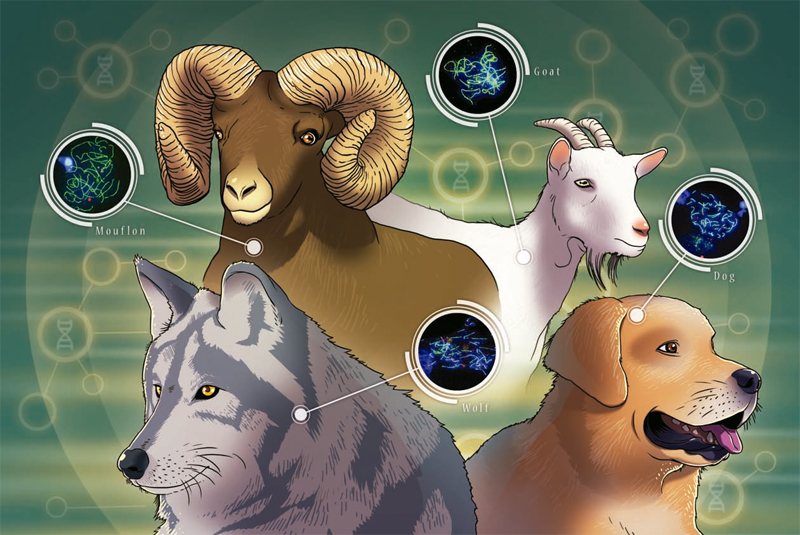Morphological and physiological diversity observed in domestic species is strikingly greater than that seen in wild species. To explain this diversity, a hypothesis was proposed some decades ago that suggested that selective forces imposed on domestic species (plants and animals) would have led to higher recombination rate in the genome of domesticates, thus allowing for new combinations of alleles, and thus also of characters. However, this hypothesis had never been conclusively tested. Using immunolabeling techniques applied to reproductive tissue (spermatocytes), recombination rate was measured in three pairs of closely related domestic and wild species: dog and wolf, goat and ibex, sheep and mouflon. Recombination rate was higher in the wild than in the domestic species, contrary to the initial hypothesis. Alternatively, it was possible that recombination rate was increased around genes of obvious phenotypic effect in domestic species (colour, size, head shape, behaviour...), preferentially selected around these regions, since humans started domesticating species, thousands of years ago. A genomic analysis comparing dogs and wolves showed no differences in the distribution of recombination events. These results suggest that the great diversity observed in domestic animals is not the consequence of significant changes in recombination rate or patterns. Currently, the scientific community strives to understand what mechanisms may be operating to generate the striking forms and shapes exhibited by domestic species. informacion[at]ebd.csic.es Muñoz-Fuentes et al (2014) Strong artificial selection in domestic mammals did not result in an increased recombination rate. Mol. Biol. Evol. 32(2):510–523 doi:10.1093/molbev/msu322
http://mbe.oxfordjournals.org/content/early/2014/11/19/molbev.msu322  Latest News
Latest News
 Las altas temperaturas están provocando que las lagunas y las marismas de Doñana pierdan agua rápidamente
Las altas temperaturas están provocando que las lagunas y las marismas de Doñana pierdan agua rápidamente
La superficie inundada en la marisma es de un 78% pero la profundidad es escasa. Por otra parte, sólo el 1,9% de las lagunas temporales están inundadas. Las precipitaciones crean una oportunidad...
 Traffic noise causes lifelong harm to baby birds
Traffic noise causes lifelong harm to baby birds
A study with CSIC participation reveals for the first time that car noise harms individuals throughout their lifetime even years after exposure
 Illegal wildlife trade, a serious problem for biodiversity and human health
Illegal wildlife trade, a serious problem for biodiversity and human health
A research team led by the Doñana BIological Station and the University Pablo de Olavide have detected wild-caught pets in 95% of the localities in the Neotropic and warns of the risk of zoonotic...
 Urbanization and loss of woody vegetation are changing key traits of arthropod communities
Urbanization and loss of woody vegetation are changing key traits of arthropod communities
Urbanization is favouring smaller beetle species and larger spider species with greater dispersal capacity.
The loss of woody areas is linked to a decline in the duration of the activity...
The loss of woody areas is linked to a decline in the duration of the activity...
 Blood lead levels in an endangered vulture species decreased following restrictions on hunting practices
Blood lead levels in an endangered vulture species decreased following restrictions on hunting practices
Canarian Egyptian vulture was on the verge of extinction at the end of the 20th century. At that time, studies revealed that lead poisoning was a serious problem for the population’s survival. The...
— 5 Items per Page
 Asset Publisher
Asset Publisher
Back






